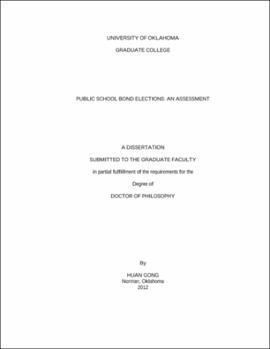| dc.contributor.advisor | Rogers, Cynthia | |
| dc.creator | Gong, Huan | |
| dc.date.accessioned | 2019-04-27T21:35:16Z | |
| dc.date.available | 2019-04-27T21:35:16Z | |
| dc.date.issued | 2012 | |
| dc.identifier | 99317483302042 | |
| dc.identifier.uri | https://hdl.handle.net/11244/319078 | |
| dc.description.abstract | School bonds provide an important mechanism of financing school capital projects. Bonds are paid back via future property taxes, which may or may not be associated with an increase in tax rates. Bond issues require voter support in local elections. Therefore, identifying factors related to bond approval is of great interest to school officials. This dissertation evaluates the literature on school bond elections, identifies methodological problems, and provides empirical applications to address these concerns. | |
| dc.description.abstract | Chapter 1 presents an overview of current conditions of public school infrastructure and financing schemes in the United States. Underfunding of school facilities remains a problem. Generally, the funding burden for school capital expenses falls upon states and local districts. Many states provide building aid in the form of lump-sum grants and matching grants (Duncombe and Wang, 2009). Eleven states do not have any building aid programs. In these states, districts rely on bonds to finance school facilities. Oklahoma is one of the eleven states that does not provide building aid. Since it is representative of the states with primary reliance on school bonds, it serves as a good case for investigating factors associated with school bond approval. | |
| dc.description.abstract | Chapter 2 focuses on voter turnout, an important factor associated with bond approval. The belief that high voter turnout reduces bond approval is widely held. This chapter identifies a potential estimation problem in examining the effect of turnout in the previous literature. Specifically, turnout is likely to be correlated with other important socio-demographic variables related to bond approval. The existing literature, however, is based on naive regression estimates, which do not properly account for this relationship. Using an instrumental variable approach, I find that voter turnout only plays a negligible role in explaining bond approval. My results question the efficacy of get-out-to-vote campaigns and other voter turnout strategies, and suggest that these efforts may not be warranted. | |
| dc.description.abstract | Chapter 3 highlights a potential selection problem in typical bond research. Specifically, school bond outcomes are observed conditional on the occurrence of bond elections. If unobservable attributes could potentially influence election participation and bond approval, then the characteristics of participating districts may not be representative of all school districts. Results from the existing literature may be suspect due to selectivity bias. As a result, I propose a two-stage model that distinguishes the bond approval (outcome stage) from the election participation (selection stage) and provides some insight regarding the effects of demographics in different stages. Even accounting for potential differences across school districts, selectivity bias is evident. To understand the mechanism by which election outcomes are achieved, self-selection needs to be given careful thought. | |
| dc.description.abstract | Chapter 4 explores the relationship between local property values and school bond approval. Property values, as a measure of property tax base, are generally viewed as an important financing resource for school capital expenses in the bond literature. In addition, school amenities associated with increased school capital spending are capitalized into local property values. Therefore, property values may be endogenous to school bond approval. The traditional ordinary least squares model may conceal the true relationship between the two due to conflicting effects. Following an instrumental variable approach, I find that property values negatively influences bond approval, and such a negative effect may reflect community heterogeneity. | |
| dc.description.abstract | Understanding and addressing the methodological problems in estimation is essential for informing policy related to school finance. My research explores interesting problems, addresses related concerns, and provides useful implications regarding school financing for policy makers. | |
| dc.format.extent | 134 pages | |
| dc.format.medium | application.pdf | |
| dc.language | en_US | |
| dc.relation.requires | Adobe Acrobat Reader | |
| dc.subject | School bonds--Political aspects--Oklahoma | |
| dc.subject | Referendum--Oklahoma | |
| dc.subject | School elections--Oklahoma | |
| dc.subject | School bonds--Oklahoma | |
| dc.title | PUBLIC SCHOOL BOND ELECTIONS: AN ASSESSMENT | |
| dc.type | text | |
| dc.type | document | |
| dc.thesis.degree | Ph.D. | |
| ou.group | College of Arts and Sciences::Department of Economics | |
